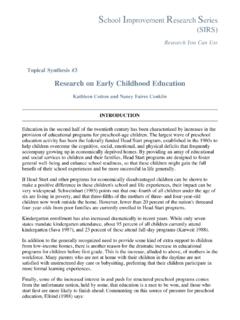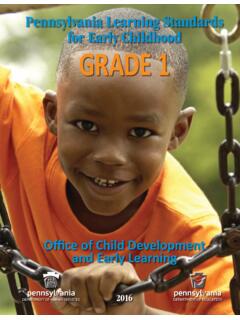Transcription of EARLY CHILDHOOD EDUCATION AND CARE POLICY …
1 NORWAYEARLY CHILDHOOD EDUCATION AND care POLICY REVIEWArno Engel, W. Steven Barnett, Yvonne Anders and Miho TagumaNORWAYEARLY CHILDHOOD EDUCATION AND care POLICY REVIEWArno Engel, W. Steven Barnett, Yvonne Anders and Miho TagumaThe statistical data for Israel are supplied by and under the responsibility of the relevant Israeli authorities. The use of such data by the OECD is without prejudice to the status of the Golan Heights, East Jerusalem and Israeli settlements in the West Bank under the terms of international credits: Khamidulin can copy, download or print OECD content for your own use, and you can include excerpts from OECD publications, databases and multimedia products in your own documents, presentations, blogs, websites and teaching materials, provided that suitable acknowledgement of OECD as source and copyright owner is given. All requests for public or commercial use and translation rights should be submitted to Requests for permission to photocopy portions of this material for public or commercial use shall be addressed directly to the Copyright Clearance Center (CCC) at or the Centre fran ais d exploitation du droit de copie (CFC) at work is published on the responsibility of the Secretary-General of the OECD.
2 The opinions expressed and arguments employed herein do not necessarily reflect the official views of the OECD member document and any map included herein are without prejudice to the status of or sovereignty over any territory, to the delimitation of international frontiers and boundaries and to the name of any territory, city or 3 EARLY CHILDHOOD EDUCATION AND care POLICY REVIEW: NORWAY OECD 2015 Foreword Norway participated in the OECD Thematic Review of EARLY CHILDHOOD EDUCATION and care (ECEC) in 1999. Since then, Norway has undertaken major POLICY reforms in ECEC in particular to expand access and improve quality in ECEC. For 2014, Norway decided to have the changed systems reviewed by the OECD team. Thus, the purpose of this Review is to explore how the ECEC systems have changed since 1999, to review the effectiveness of the changes made, and to investigate what are the most effective, relevant and feasible POLICY options to further improve access and quality in its ECEC system.
3 To this end it delivers an independent analysis of major issues in the areas of governance, funding, access and, in particular, quality of kindergarten provision in Norway, looking at past and present POLICY initiatives, and potential approaches for the future. The report serves to provide insights and advice to the Norwegian kindergarten authorities at all levels of government, practitioners and stakeholders, helping them to ensure high quality in all kindergartens, give even more children access to a place in a kindergarten and ensure good governance appropriate for today s and future kindergartens. The report is also intended to help other OECD member and non-member economies to understand the Norwegian ECEC systems. This report forms part of the project Review of policies and practices for monitoring quality in EARLY learning and development . In addition to the country review strand, Norway contributed to the data development and monitoring quality strands of this work.
4 Accordingly, key findings from those strands are also included in the present review report. The review was conducted based on two visits: a fact-finding mission and a POLICY review mission. The members of the fact-finding mission included: Miho Taguma (OECD Secretariat, ECEC project manager), Arno Engel (OECD Secretariat, co-ordinator of the Review), W. Steven Barnett (Director, NIEER, Rutgers University), Christa Preissing (Director, Berliner Kita-Institut f r Qualit tsentwicklung - BeKi) and Mugyeong Moon (OECD Secretariat, seconded from Korea Institute of Child care and EDUCATION ). The members of the POLICY review mission included: Miho Taguma, Arno Engel, W. Steven Barnett, Christa Preissing and Masafumi Ishikawa (OECD Secretariat, seconded from Japanese Ministry of EDUCATION , Culture, Sports, Science and Technology). The report was prepared under the leadership of and reviewed by Miho Taguma.
5 The main authors are Arno Engel, W. Steven Barnett and Yvonne Anders (Professor, Department of EARLY CHILDHOOD EDUCATION at Freie Universit t Berlin). The Secretariat provided extensive information, analysis and discussion in regard to ECEC governance, policies, provision and financing as well as the two key areas of the review, access and quality. Research assistance was provided by Christa Crusius (OECD Secretariat), Elizabeth Adamson (University of New South Wales) and Ana Sushac (Freie Universit t Berlin). The report also benefitted from the comments and assistance of Ineke Litjens, tienne Albiser, Paul O'Brien and Isabelle Chatry (OECD Secretariat). Administrative support was provided by Claude Annie Manga Collard and Kelly Makowiecki. Sophie Limoges helped with finalising the publication. Editorial support was provided by Sally Hinchcliffe. The layout was prepared by Liz Zachary.
6 4 - FOREWORD EARLY CHILDHOOD EDUCATION AND care POLICY REVIEW: NORWAY OECD 2015 Norway s involvement in the OECD Review was co-ordinated by Ms. Tove Mogstad Slinde and Ms. Aase Birgitte Gimnes, Senior Advisers, Norwegian Ministry of EDUCATION and Research. A key part of Norway s preparation was the crafting of a comprehensive and informative Country Background Report (CBR) on its EARLY CHILDHOOD EDUCATION and care (ECEC) system and policies, published by the Ministry of EDUCATION and Research jointly with the present report. The review team is highly indebted to the authors of the CBR, and to all those who supported them with providing such a comprehensive and informative report. The CBR is an important output from the review process in its own right as well as the main starting point and resource for the review team. The CBR is referenced as Ministry of EDUCATION and Research, 2015 throughout this report.
7 The CBR follows the questionnaire and guidelines prepared by the OECD. This report and the CBR should be read together so that the readers could gain a full picture of the Norwegian POLICY contexts and be able to triangulate the POLICY issues between the reader s own assessment, the internal assessment by the Norwegian authority and the external assessment by the OECD review team. The fact-finding mission took place on 10-13 June 2014, including visits to Oslo, Drammen and Hole. The POLICY review visit took place on 9-15 September 2014 and covered visits to Oslo, Bergen, Troms and K fjord. The itineraries for both visits are provided in Annex A. The visits were planned jointly by the OECD Secretariat and the Norwegian authorities. During the review visit, the team held discussions with a wide range of national, regional and local authorities; officials from the Ministry of EDUCATION and Research.
8 Those meetings and visits sought to provide a broad perspective on ECEC policies and practices in Norway. The review team is extremely grateful for the insightful discussions, helpful comments and explanations and the time dedicated to the review by the various people it had the pleasure to meet. Our special thanks goes to Ms. Tove Mogstad Slinde and Ms. Aase Gimnes who shared their expertise and answered the never-ending questions of the review team throughout the two visits. Thanks to the hospitality of all Norwegian stakeholders, the visits were inspiring and, due to the wealth of information received, intellectually challenging but enjoyable. This report is organised in three chapters. Chapter 1 provides the national context, with information on Norway's demography, welfare state, EDUCATION policies and key reforms. Chapter 2 looks at governance, funding and access with strengths, challenges and POLICY recommendations for all areas.
9 Lastly, Chapter 3, the main chapter of the report, focuses on quality in the area of workforce, standards and regulations, monitoring and research, again identifying strengths, challenges and suggesting POLICY recommendations. TABLE OF CONTENTS 5 EARLY CHILDHOOD EDUCATION AND care POLICY REVIEW: NORWAY OECD 2015 Table of contents List of abbreviations .. 9 Executive summary .. 11 Chapter 1 National context and overview of EARLY CHILDHOOD EDUCATION and care .. 13 The Norwegian context: Political system, geography and demography .. 14 Social and EDUCATION POLICY context .. 15 ECEC reforms and POLICY trends in Norway .. 19 Chapter 2 Ensuring access through effective governance and funding .. 25 Key messages .. 26 Introduction .. 26 Strengths, challenges and POLICY recommendations .. 28 Governing and financing kindergartens .. 29 Integrated and local governance .. 29 Strong public funding and local decision making.
10 30 Strengths .. 33 Challenges .. 34 POLICY recommendations .. 35 Ensuring access to kindergarten .. 36 Strengths .. 36 Challenges .. 40 POLICY recommendations .. 43 Annex .. 54 Chapter 3 Enhancing quality in EARLY CHILDHOOD EDUCATION and care .. 57 Key messages .. 58 Introduction .. 58 Concepts of quality in EARLY CHILDHOOD EDUCATION and care .. 60 Strengths, challenges and POLICY recommendations .. 61 Workforce quality .. 62 Strengths .. 63 Challenges .. 66 POLICY recommendations .. 69 Standards and regulations .. 74 Strengths .. 75 Challenges .. 78 POLICY recommendations .. 79 Monitoring .. 82 Monitoring service quality .. 83 Monitoring staff quality .. 85 Monitoring child development and well-being .. 85 6 TABLE OF CONTENTS EARLY CHILDHOOD EDUCATION AND care POLICY REVIEW: NORWAY OECD 2015 Strengths .. 86 Challenges .. 88 POLICY recommendations .. 91 Research .. 95 Strengths .. 96 Challenges .. 98 POLICY recommendations .. 98 Discussion and conclusion.













